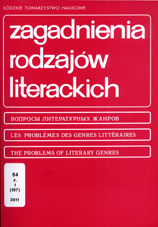Suspended between "Ville' and "Unreal City": The Symbolist Roots of T. Eliot's Urban Vision
Suspended between "Ville' and "Unreal City": The Symbolist Roots of T. Eliot's Urban Vision
Author(s): Alicja PiechuckaSubject(s): Literary Texts
Published by: Łódzkie Towarzystwo Naukowe
Summary/Abstract: T. S. Eliot's vision of the modern metropolis is heavily indebted to the French symbolists' treatment of the city. The figure of the urban {laneur, present in Gerard de Nerval's and Charles Baudelaire's poetry, resurfaces in Eliot's reuvre. The fliineur soon turns into the dreamer, and following in the French poets' footsteps, Eliot shifts from the urban and the real to the oneiric and the phantasmagorical. The nocturnal city becomes almost surreal, gravitating away from the concrete and towards the mysterious, the fantastic and the abstract. Joining the Plato-symbolists in their quest for the idea and the ideal, for abstraction and generalisation, Eliot, influenced largely by Arthur Rimbaud, creates an urban amalgam, multicultural and all-embracing, fusing past and present, the historical and the mustic, the natural and the urban, splendour and monstrosity. The resultant marriage of contradictions emphasises the painfulness and misery of the actual. The city thus presented is par excellence a microcosm of the universe and mankind, at once cosmopolitan and debased. Though Rimbaud's images are altogether more dynamic and flamboyant, what the two poets have in common is the prophetic dimension of their urban vision: a sence of impending doom underlies their magic-mythic metropolitan geography, and theirs is a world tottering on the edge of disintegration. Nevertheless, inherent in the symbolist-Eliotesque picture of urban degradation and spiritual atrophy is vague hope for regeneration, which the poets in question will seek to realise by other means.
Journal: Zagadnienia Rodzajów Literackich
- Issue Year: 54/2011
- Issue No: 1
- Page Range: 281-295
- Page Count: 15
- Language: English

